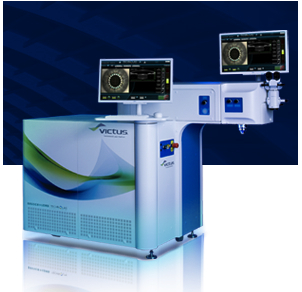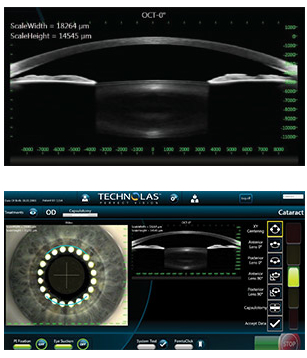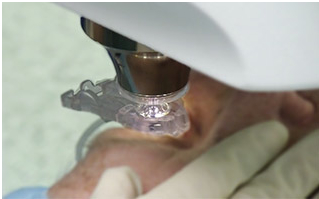 Valeant Pharmaceuticals International, Inc. has announced that its wholly owned Laval, Quebec based subsidiary Bausch + Lomb has received 510(k) U.S. Food and Drug Administration (FDA) clearance for the company’s new advanced Swept Source OCT (Optical Coherence Tomography) imaging system.
Valeant Pharmaceuticals International, Inc. has announced that its wholly owned Laval, Quebec based subsidiary Bausch + Lomb has received 510(k) U.S. Food and Drug Administration (FDA) clearance for the company’s new advanced Swept Source OCT (Optical Coherence Tomography) imaging system.
Also receiving FDA approval is Valeant’s updated software for its VICTUS Femtosecond Laser Platform, presenting surgeons with a new, redesigned intuitive interface designed to facilitate faster, simpler, customized treatment planning that will enable surgeons to improve efficiency and optimize patient-flow during surgical procedures.
 “With the availability of the advanced OCT imaging and software enhancements, surgeons can monitor treatments in real-time and with exceptional clarity throughout entire procedures, providing even greater control and consistency to support outstanding surgical outcomes for their patients,” says Dr. Ari Kellen, Valeant executive vice president and company group chairman. “These new advancements demonstrate Valeant’s commitment to innovation in eye health. We want to deliver technologies that improve clinical practice and provide the best quality of vision to patients.”
“With the availability of the advanced OCT imaging and software enhancements, surgeons can monitor treatments in real-time and with exceptional clarity throughout entire procedures, providing even greater control and consistency to support outstanding surgical outcomes for their patients,” says Dr. Ari Kellen, Valeant executive vice president and company group chairman. “These new advancements demonstrate Valeant’s commitment to innovation in eye health. We want to deliver technologies that improve clinical practice and provide the best quality of vision to patients.”
 The Bausch + Lomb Swept Source OCT imaging system features support for high-resolution imaging of an entire procedure and can also be used to control incision depth and detail the architecture of arcuate incisions. Used together, the new Victus software and Swept Source OCT imaging system can provide auto-recognition of key ocular landmarks, including the pupil, anterior capsule and posterior capsule, along with providing capsule tilt compensation to maximize lens fragmentation.
The Bausch + Lomb Swept Source OCT imaging system features support for high-resolution imaging of an entire procedure and can also be used to control incision depth and detail the architecture of arcuate incisions. Used together, the new Victus software and Swept Source OCT imaging system can provide auto-recognition of key ocular landmarks, including the pupil, anterior capsule and posterior capsule, along with providing capsule tilt compensation to maximize lens fragmentation.
Additional features of the advanced Swept Source OCT and software include improved imaging speed and sensitivity compared with conventional time domain detection techniques as well as unprecedented responsive video frame rate speed; high-contrast, imaging with exceptional detail and clarity allow Optical Coherence Tomography-guided adjustment for all phases of cataract and corneal procedures during docking through planning and non-stop throughout treatment; OCT-guided planning of up to two arcuate incisions which can be independently configurable for diameter, depth, position and size and presenting a magnified cross-sectional scan that allows for incision depth adjustment through pachymetry;
and improved docking facilitated by high-contrast, live streaming OCT.
 “As a user of the VICTUS femtosecond laser platform, I’m very excited about the latest upgrades for this versatile platform”, says Terrence P. O’Brien, M.D. , professor of Ophthalmology and Charlotte Breyer Rodgers distinguished chair at the Bascom Palmer Eye Institute of the University of Miami Miller School of Medicine,s diseases. “The advanced higher resolution imaging system and faster, more intuitive software will allow cataract surgeons to be more efficient, accurate and precise than ever before. It has been gratifying to collaborate with the innovative team from Valeant and Bausch + Lomb to help develop and deliver crucial technological enhancements to better assist cataract surgeons in providing excellent visual outcomes for their patients.”
“As a user of the VICTUS femtosecond laser platform, I’m very excited about the latest upgrades for this versatile platform”, says Terrence P. O’Brien, M.D. , professor of Ophthalmology and Charlotte Breyer Rodgers distinguished chair at the Bascom Palmer Eye Institute of the University of Miami Miller School of Medicine,s diseases. “The advanced higher resolution imaging system and faster, more intuitive software will allow cataract surgeons to be more efficient, accurate and precise than ever before. It has been gratifying to collaborate with the innovative team from Valeant and Bausch + Lomb to help develop and deliver crucial technological enhancements to better assist cataract surgeons in providing excellent visual outcomes for their patients.”
An internationally renowned physician, researcher, and educator, Dr. O’Brien has treated many prominent individuals including congressmen, professional athletes and media personalities. Dr. O’Brien is recognized as an exceptional surgeon, with clinical specialties in cataracts and intraocular lens, laser vision correction, corneal and external diseases, ocular infectious diseases and corneal transplant surgery.
A Valeant release notes that Bausch + Lomb has been installing VICTUS platforms at advanced surgery centers globally since the [product received CE mark in November 2011 and FDA clearances in July 2012. THe company states that that VICTUS “is now one of the only femtosecond lasers in the U.S. with clearance for the creation of a corneal flap in patients undergoing LASIK surgery, anterior capsulotomy during cataract surgery, penetrating arcuate cuts/incisions in the cornea and laser-assisted lens fragmentation during cataract surgery.”
Since its initial approval in 2011, the VICTUS platform has received additional CE marks including corneal incisions, penetrating keratoplasty and the creation of intrastromal channel incisions for intracorneal ring segments. Valeant describes VICTUS as an extension of the surgeon’s own skilled hands, allowing him or her to begin every procedure with accuracy and control. Noting that ophthalmic surgery, by its nature, requires utmost precision, and until now that level of precision has been achievable only by application of painstaking effort.
However, now there’s VICTUS’s Advanced docking technology — designed to reduce the possibility of eye tilt and distortion and allow for better centration, more precise cutting and fragmentation, greater stability, and reduced vacuum requirements — meanwhile minimizing the potential for posterior corneal folds or ripples. surgical field visibility is enhanced by the live-action optical coherence tomography, keeping the surgeon consistently in command from the planning through treatment and recovery stages.
The VICTUS OCT technology with, its easy-to-use graphic interface is able to provide advanced visual guidance at all times, and used in conjunction with the VICTUS Intelligent Pressure Sensors, enables the surgeon to control procedure-optimized downward pressure, complete with customized settings for corneal and cataract applications.
 Photo Caption: Minimizing the possibility of corneal folds helps to maintain the high quality of the laser beam to provide precise cuts – Image Courtesy VICTUSLAser
Photo Caption: Minimizing the possibility of corneal folds helps to maintain the high quality of the laser beam to provide precise cuts – Image Courtesy VICTUSLAser
However, Valeant points to the unmatched capabilities of VICTUS is the laser itself as key, with the VICTUS’s fast laser pulse rates and small spot size kicking accuracy and consistency to a new level. Femtosecond lasers emit optical pulses of extremely short duration in the domain of femtoseconds, as short as one-quadrillionth of a second. Consequently, these ultra-short pulses don’t transfer either heat or shock to material being cut, and can make extremely precise surgical incisions. The technology was developed in the early 1990s at the University of Michigan Engineering Center, and the first commercial platform was introduced in 2002, with the original approval for flap creation during LASIK surgery. Today the technology facilitates elegantly-executed procedures conducted with equal measures of confidence and control.
Thanks to Dual-Modality Performance, the two-piece, curved interface and Intelligent Pressure Sensors, VICTUS has the unique ability to dock with full contact for corneal applications, and to utilize a liquid layer for cataract applications. Additionally, the surgeon has the option of shifting modalities during a procedure, seamlessly adapting to the particular requirements of individual cataract and corneal surgeries.
For more information about the VICTUS Femtosecond Laser Platform, visit:
http://www.victuslaser.com/
Sources:
Valeant Pharmaceuticals International, Inc.
Bausch + Lomb
Image Credits:
Valeant Pharmaceuticals International, Inc.
Bausch + Lomb

